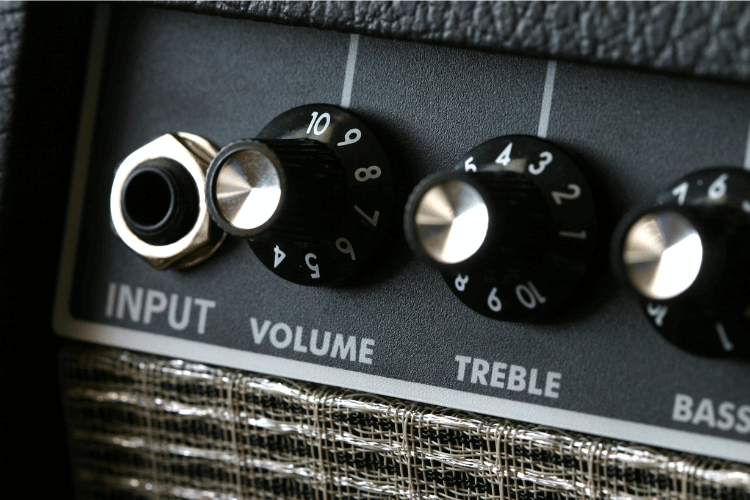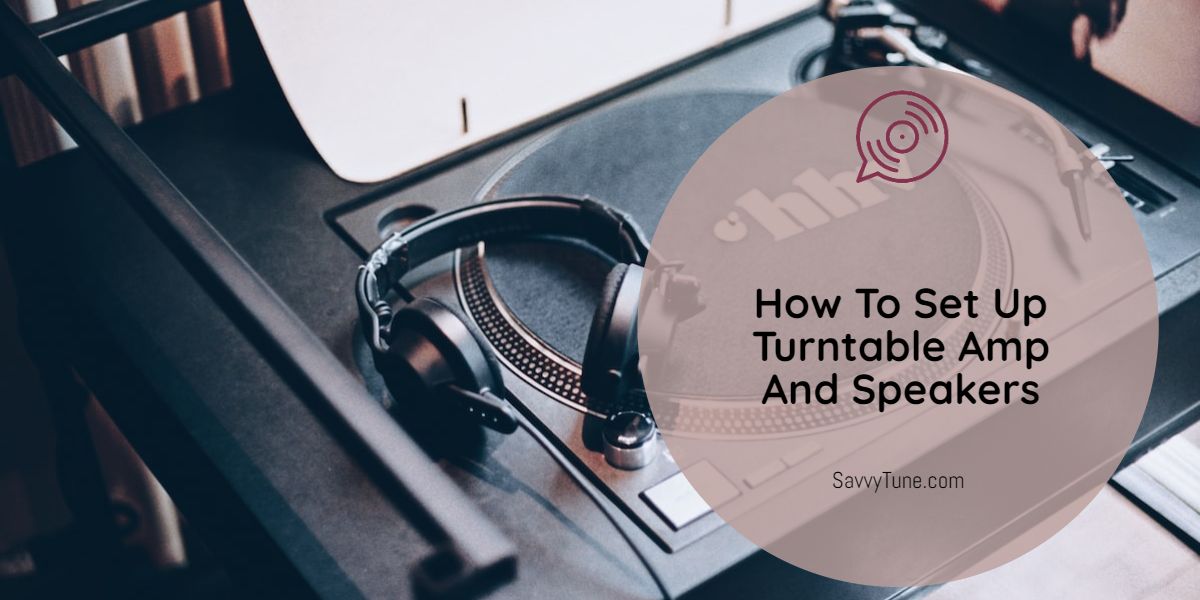The global turntable market size has increased exponentially in the past few decades. In 2020, the retail sales value of turntables reached a jaw-dropping $361.6 million—and is expected to reach over $500 million in 2028.
Music lovers far and wide were charmed by its unique analog experience and nostalgic sound, which contributed to its booming popularity.
If you’re one of those people who adore the look, feel, and sound of a turntable but don’t quite know how to set it up, I’m here to help. In this article, I’ll show you how to set up a turntable amp and speakers to get the best possible sound out of your turntable system.
Setting Up a Turntable System: A Brief Overview
To set up your turntable amp and speakers, you’ll first need to connect the amp via RCA cables to your turntables. Then, connect the amp to your speakers. If your turntable doesn’t come with a built-in preamp, you’ll either need to invest in a separate preamp device or an amp with a built-in preamp.
Basic Components of a Turntable System
Your turntable setup is largely dependent on the physical space you have in your setup, the system’s integration with other audio components, the type of music you’re looking for, and your budget. Generally, though, a standard turntable system is made up of three components apart from the turntable itself: a phono preamp, an amplifier, and speakers.
Phono Preamp
Phono signals produced by record players are a thousand times lower than the signals coming from a CD player or a streaming device. To boost these signals to usable levels, you need a phono preamp.
A phono preamp, also known as a phono preamplifier, converts the phono output signal that your cartridge produces into an AUX or line-level signal.
It equalizes or balances the signal so the sounds produced by the turntable system stay as true-to-original as possible.
If you use your turntable without a phono stage, it’ll produce a reedy, thin, sound that’s so quiet it’s unlistenable.
Some turntables, like the Audio-Technica AT-LP60X and the Sony PS-LX310BT, come with a built-in phono preamp. Others, like the Rega Planar 1 and Planar 2, don’t.
If your turntable doesn’t have a phono preamp already built-in, you’ll need to invest in a separate preamp stage or an amplifier that includes its own.
Amplifier
The amplifier amplifies the phono preamp’s weak signal and transfers it to the speakers.
If you have an integrated amp, you can hook up your turntable directly into the phono input at the back. If not, you’ll have to connect the preamp to the amplifier first.
Without an amplifier, you won’t be able to hear the music produced by your turntable.
Speakers
To start playing music from your turntable, it needs to be connected to a speaker. The high-end frequencies produced by the amplifier travel to the speaker’s tweeter, and the low-end frequencies move to its bass driver and mid-range. These signals produce the sound you actually hear from the speakers.
Speakers come in two different options: passive and powered.
Passive speakers don’t have their own built-in amplifier, so they’re powered through a separate amp like an A/V receiver. The amp receives the audio from the phono preamp and the preamp boosts it to detectable levels before sending it to the speakers. They’re connected through a speaker wire to the amplifier.

Active speaker systems, on the other hand, are equipped with a built-in amplifier. They take line-level signals from the audio source and amplify them internally, so they don’t require an external amp.
How to Set Up Turntable Amp and Speakers: A Step-by-Step Guide
Now that we’ve discussed the primary components of a turntable setup, here’s how to use them together:
Step 1: Place Your Turntable On a Solid Surface
Place your turntable on a flat, even surface to prevent tracking issues and tonearm friction when playing your records. On a flat surface, the record player will be less inclined to pick up vibrations from external components.
You also need to make sure the record player doesn’t produce internal vibrations.
Some record players have built-in suspensions to counteract unwanted vibrations, while others use their own mass to keep the turntable as sturdy as possible.
If your turntable uses either and still produces vibrations, you might want to incorporate isolation feet if your record player doesn’t already have them.
Related: 9 Best Turntables For Scratching
You can also use a turntable mat or a turntable isolation platform to keep vibration at bay and minimize unwanted acoustic feedback.
Step 2: Position Your Speakers
When positioning your speakers, place them on a separate surface to avoid passing the vibrations to your turntable.
This is especially critical if your speakers are capable of producing deep bass.
You need to make sure your speakers and record player don’t interact with each other too much to get the best sound.
As a rule of thumb, you should place your speakers at roughly ear height from your chosen listening position. If you’re listening to your records on your sofa, the speakers should be around the height of your ears when you’re sitting.
Also, make sure they’re not flush against the wall as it’ll reflect sound waves, resulting in time smearing.
Step 3: Connect the Turntable to the Phono Amp
Connect your turntable to your phono stage or the amplifier’s phono input with RCA cables. Make sure to pay attention to the left and right connection options. The red wire should be placed on the right channel, while the black or white wire should be placed on the left channel.
If your turntable uses a ground wire, connect it to the ground screw on your receiver or phono preamp.
Step 4: Connect the Amp to the Speakers
Once you’ve connected the phono stage to your amplifier, you’ll then need to connect your amplifier to your speakers. If your amplifier comes with built-in speakers, you don’t need this step. Just plug it in and start playing your songs.

And that’s it! You’ve not set up your turntable system optimally.
How to Prevent Interference In Your Playback
Turntables and other analog sources will never be dead quiet like digital audio sources.
No matter what you do, you’ll always hear some level of buzz or hum if the volume is turned up with no music playing.
But if you hear some noise with music playing, the turntable might be experiencing interference.
Interference creates excess noise during playback. The noise is typically a hum, buzz, hiss, or static sound.
If you hear these sounds, your turntable is likely near an electronic device. Position it away from high-powered electronics and devices with wireless transmitters. This includes cordless phones, routers, TVs, and Wi-Fi–based speakers.
The transformers in amps also emit noise. Transformers are usually located on the left side of the device, so it’s recommended that you place your turntable on the right side of the amp.
Avoid placing the turntable directly on top of the receiver as this not only increases buzzing but also prevents the receiver from getting proper airflow.
5 Common Turntable Setups
There are dozens of ways to set up your turntable system. Some of the most common include:
1. Turntable With Built-In Preamp + Speakers With Built-in Amplifier
With this setup, all you’ll need to do is to plug your turntable into a power source and connect it to powered speakers via an RCA cable.

Since powered speakers come with built-in amplifiers and the turntable with a built-in preamp, this setup doesn’t need a separate preamp or amplifier to work.
User Also Read: Best Phono Cartridge Under $200
This makes it suitable for beginners or those looking for a more minimal and plug-and-play setup.
2. Turntable + Preamp + Powered Speakers
If your turntable doesn’t come with a built-in preamp, this setup is for you.
Instead of just the turntable and powered speakers, this setup adds a separate preamp into the mix. The preamp delivers a cleaner, more accurate signal, with lower noise, less distortion, higher gain, and more headroom.
3. Turntable + Preamp + Amplifier + Passive Speakers
If customization is important to you, you’ll find this setup most agreeable.
With this setup, you’ll be able to replace and upgrade specific components of your turntable system as better alternatives pop up in the market.
This allows you to get the exact sound you prefer when using your turntable.
4. Turntable + A/V Receiver + Passive Speakers
In this setup, you’ll plug your turntable into an A/V receiver and the A/V receiver into two or more speakers.
This allows you to connect your turntable to an existing home theater speaker setup.
Some receivers come with a built-in preamp, so they pair perfectly with turntables without built-in preamps.
5. Turntable With Built-in Preamp + Bluetooth Speaker
If you want to minimize the use of cables as much as possible, this setup is your best bet. Simply plug in your turntable and connect it to your speakers via Bluetooth. This setup allows you to space your speakers further apart without cables limiting the distance.

